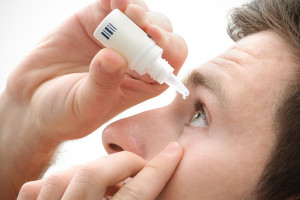The “Dos and Don’ts” of Eye Drops

The typical day in this modern era in which we live no doubt has a vast array of benefits. Everything you need is available at the touch of a button. All you have to do is whip out your laptop or phone and, within a matter of minutes, you have ordered your groceries! And yet, this screen-dominated life does have its drawbacks.
It’s a sad fact that today, many of our eyes are suffering from a severe lack of moisture.
No, I’m not saying that we don’t cry enough – although some blubbering emotional therapy surely wouldn’t hurt. The simple truth is that the same screens that have made our lives easier and, in many ways, more entertaining, are also wreaking havoc with our eyes.
Screen use and the consumption of media have now become our predominant pastime. For many of us, a long day of staring at a computer screen at the office is readily replaced in the evenings with a binge-watching session of our new favourite TV show. Sound familiar?
You may also be familiar with that feeling of peeling yourself away from the screen, rubbing your strained and irritated eyes, only to see a blur of what was the world around you. This is a typical experience of Computer Vision Syndrome, or CVS – otherwise known as digital eye strain.
Digital Eye Strain
It’s hard to know exactly how many people experience digital eye strain, but with screens becoming an increasingly normal part of our day, we bet it’s a lot. Around 88% of people aged 18-39 and 83% of those aged 40-59 now use a digital device for at least two hours a day.
Our eyes might be one of the fastest healing parts of the body, but they are also incredibly sensitive to changes in conditions. Luckily, they can also give us various warning signs, such as soreness or blurry vision. However, if we don’t heed these signs, our eyes can develop all sorts of issues.
As with many things, the best solution to digital eye strain is prevention. Cutting down on our screen time, such as by implementing the 20-20-20 method, can be extremely useful.
Dry Eyes
As we said earlier, our eyes are extremely sensitive to changes in conditions. This is also why dry eyes is the most common side effect of Laser Eye Surgery.
While Laser Eye Surgery itself is usually a minimally-invasive procedure that causes very little disruption to the eyes, it is important that care is taken to ensure that eye dryness associated with treatment is managed effectively.
This is precisely why we provide eye drops to all our patients. We recommend that you apply your eyedrops whenever you feel mild discomfort or irritation, which can often be the case when you sit for long periods in air-conditioned rooms or stare at a screen for too long.
While our eyedrops are useful at preventing dry eyes and promoting comfort, it is important to note that they do not safeguard your eyes against overexertion. Therefore, we also have guidelines of best practices to follow throughout the recovery process. This includes guides on when you can return to activities like flying and drinking alcohol – two activities that also dry out your eyes.
But here the focus is eye drops, which, if used correctly, will most likely only be required for a brief period – from one or two days to a fortnight at most.
The eyedrop checklist
The number one rule when using eyedrops is hygiene: always wash your hands thoroughly with soap and water before applying them.
Your hands are one of the biggest risks when applying anything to your eyes – from makeup to contact lenses. They can easily transfer dirt, grit, and bacteria that can cause irritation and lead to infections.
You will also want to ensure that your dropper is kept clean. Therefore, ensure that the end of the dropper is not chipped or cracked, and try your best not to touch it with your hands. Importantly, you should also avoid touching the dropper to your eye, eyelid, lashes, or any other surface. This will help to keep it clean and free from any bacteria or other contaminants.
If the dropper does become dirty, you can simply buy a new one or ask us for a replacement at your next aftercare appointment or over the phone!
Sharing another person’s drops is also a big no-no. Doing this is an incredibly easy way to spread infection – one that can easily be avoided by making sure you have a good supply of your own drops – particularly when travelling or at work.
With the ground rules laid out, let’s look at how you should go about keeping your eyes moist.
How to apply eye drops
Squeeze the end of the dropper – with clean hands, remember! – to suck some of the solution from the bottle. From here, tilt your head back whilst pulling your lower eyelid down with one or two of your fingers. This will open up a small ‘pouch’ where you should aim to apply the drops.
Gently squeeze the dropper to apply one or two drops (your surgeon will tell you the ideal quantity for you) into the opening, and then do the same for the other eye. Close both eyes for a minute or so, tilting your head down as though looking at the floor to help the drops spread across the eyes and absorb. Try not to blink or squeeze your eyelids.
If you’re using more than a few drops in the same eye, you may have to wait a few minutes before adding the next drop. Finish the ritual as you began – by washing your hands.
And it’s as simple as that. If you have any more questions about using eye drops, be sure to ask your surgeon at an aftercare appointment or simply give us a call on 020 7224 1005.


